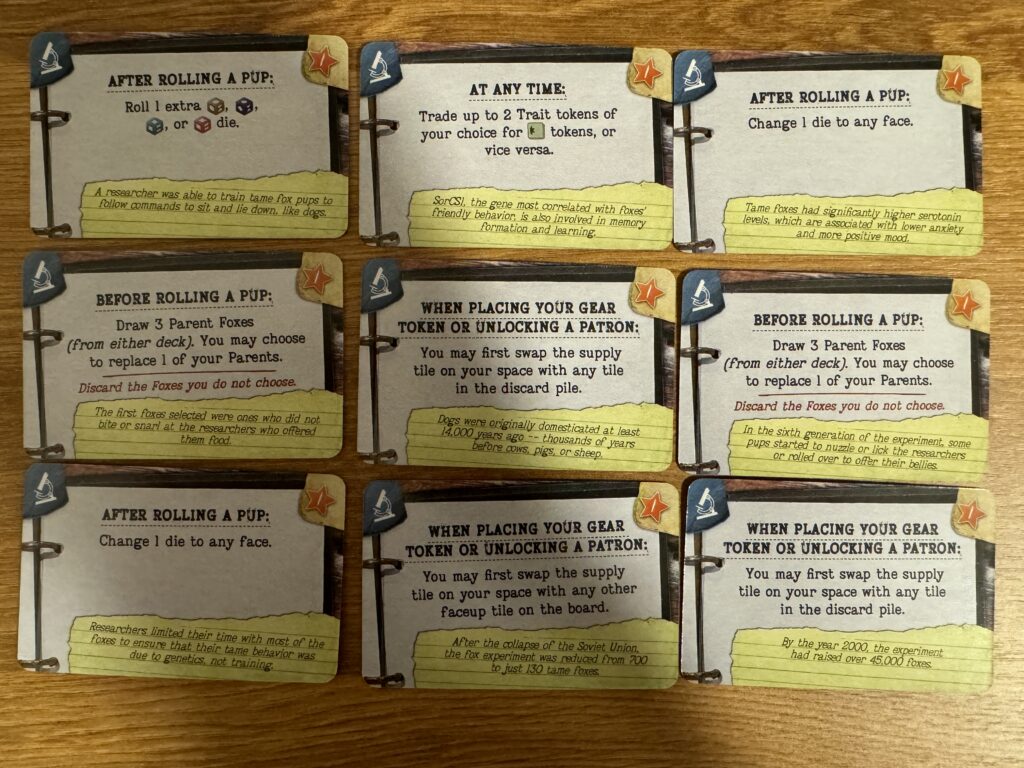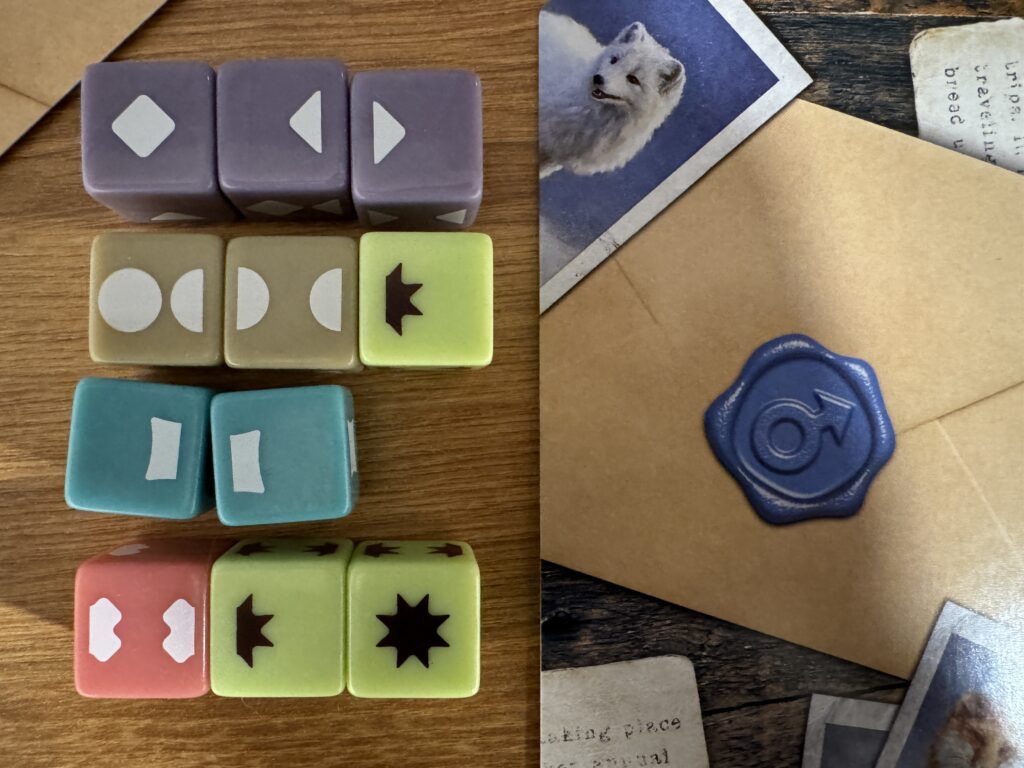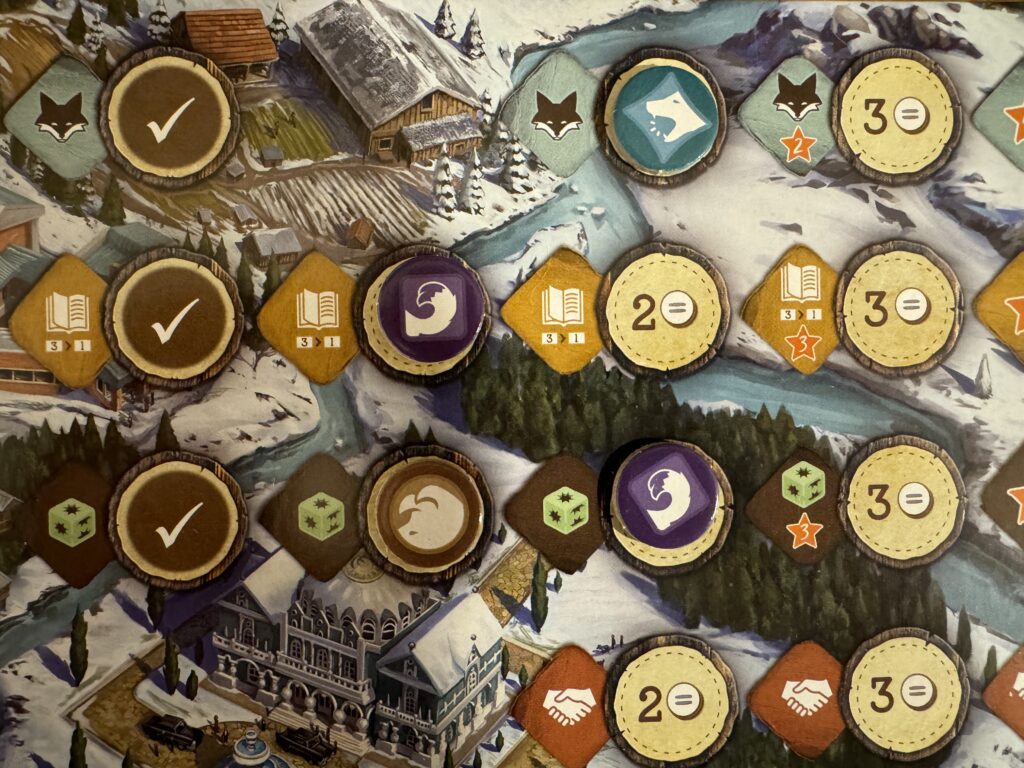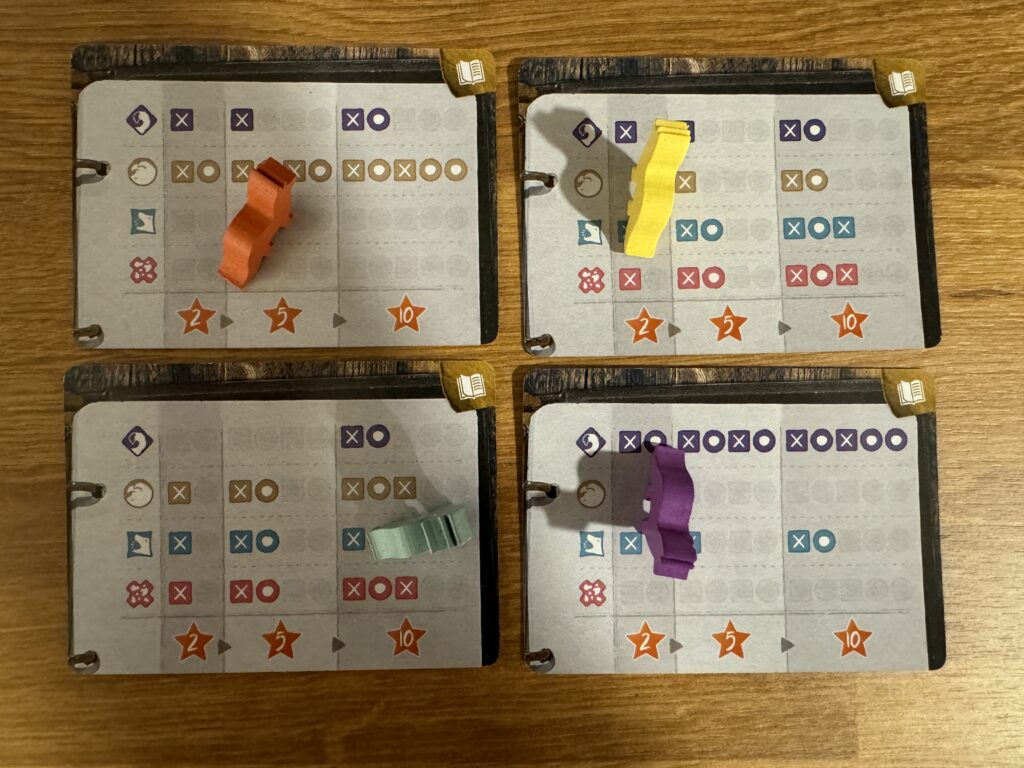The Fox Experiment, a foxy roll and write board game published by Pandasaurus Games, is built around the domestication research done by Demitri Belyaev and Lyudmila Trut in the 1950s as they explored the effects of breeding foxes that exhibited the most friendly traits.
Designed by Jeff Fraser and Elizabeth Hargrave, The Fox Experiment board game will have you rolling increasing numbers of dice to mark out traits for the foxes you help breed, ramping up all the way through the final turn. It’s a game that channels that great feeling of ‘number go up’ and ‘brrrt’ that everyone tends to enjoy.
So, give your furry friends a cuddle before diving in to look at The Fox Experiment with me!
The Fox Experiment Gameplay
The Fox Experiment begins as most board games do, with a tableau selection of male and female foxes that you can choose to help you breed the next generation of friendly foxes. Oh wait…not all board games begin like that, do they? After drafting each of your foxes and an upgrade token that determines the next Generation’s turn order, it’s time to roll dice and build your traits.
Each fox has any number of dice icons on its front face. You’ll take those dice, along with any wild dice as indicated on your player mat, and roll them all. For each color, the goal is to create as many complete icons as possible. Some of the dice faces have a complete icon already, which some have just a half, and others have halves facing opposite ends. Placing the dice side by side forms those complete icons.
You also have the option of spending some wild tokens – one use only – to complete icons as well. This can be an easy way to get over the hurdle associated with your Study cards. I’ll get to those in a second here.
Using the dry erase marker, mark one spot on your new fox for each completed icon per Trait. Then, you can assign your bred foxes to your Studies, which each have three levels to complete. If your fox has the necessary Trait requirements, you can progress through that Study, which will grant you bonus points at the end of the game.
For each circle that you fill in on your bred foxes, you receive a Trait token. These can be spent during the round to upgrade your board. Upgrades allow you to do things like breed more foxes each Generation, unlock additional Studies, gain a Patron that grants more ways to gain endgame points, or unlock extra wild dice to roll when breeding.
Whichever fox has the most spaces filled in on their card is the Friendliest, and that player marks the Generation track with a fox meeple accordingly.
The bred foxes then become the parent foxes in the next Generation, and the game continues until the end of Generation 5 at which point scores are tallied. Highest points is the winner!
Staking Our C.L.A.I.M. on The Fox Experiment!
![Fox Experiment Board Game icon]() Components
Components
Overall, I am exceptionally pleased with the components in The Fox Experiment board game. The fox meeples are astounding, with several different poses in each of the included colors. The also have a distinct clackety kind of sound when they knock together that sounds a bit closer to plastic than wood, but it’s also very satisfying.
The acrylic dice are also fantastic. They’re the same material as the white tracker cubes in Terraforming Mars – which is one of my most beloved board game components – or similar cubes in Elevenses. And when you have a pile of those in your hand, rattling around and ready to roll, you’ll know exactly why they are so wonderful.
My main issue with the components is actually with the rulebook. Apart from the inaccuracies on the Player Aid cards – which is well documented on the BGG forums – I found the rulebook to be somewhat difficult to follow. Despite being 35 pages, the layout consists of examples in the margins with the main rules text in the middle towards the binding. The ordering of the examples would intuitively want me to read those first, which would often reference rules that hadn’t come up yet. This led to confusion, thinking I’d missed something. Additionally, the solo rules are similar to the 2-player rules, so you have to flip back and forth between those sections to get the entire picture.
Lastly, I’ll mention that I’m happy with the decision to use dry-erase markers, as I am really tired of writing on disposable sheets for my roll and write games. Plus one for that.
![Fox Experiment Board Game icon]() Luck
Luck
When we’re talking strategy for The Fox Experiment board game, there seems to be a lot of illusion of choice in the game. The main player interaction comes along when selecting your turn order and foxes at the beginning of a generation, but after that you are mainly just manipulating your dice, trying to optimize the results while everybody else does the same.
It seemed really difficult to actually not just get progressively better and better foxes, along with everyone else. And it tended to be rare for me to be truly disappointed with a parent fox as a result. Your meaningful decisions then lie with proper usage of your wild tokens and wild dice to help you build out your Studies. Even then, towards the end of the game you probably have enough wild resources to pretty much make whatever fox you need to complete those Studies.
I found myself prioritizing dice upgrades and being able to breed multiple foxes early on and that always seemed to go well. Because of the increased cost of player mat upgrades, I also tended to unlock all of the lower costs first, and wait for the Patrons until closer to the end of the game to help round out my score. At the end of the day, this is a roll and write board game, and The Fox Experiment sort of guides you along those familiar rails without allowing you to veer too far off course.
![Fox Experiment Board Game icon]() Aesthetics
Aesthetics
The Fox Experiment board game looks delightful, and you’ll be marveling at the fox illustrations – of which there are numerous. Add some flashy dice colors on top of that and you have a game that certainly will turn heads visually, if the clattering of piles of dice didn’t draw attention of passerby first.
My only issue with the iconography is that the Ears Trait icon just looks like an eagle to me. No matter how much I try to Magic Eye my way through it, it always has that bird look. What am I missing? Note: okay, I can see the orientation it has to be now, but it still bothers me a little bit!
Again, that’s a small price to pay for what is otherwise a very appealing-looking game on its face. Just be mindful of the difference between dice and traits and how each of those resources interact with the rest of the board.
![Fox Experiment Board Game icon]() Interest
Interest
Now we get down to brass tacks and talk about who The Fox Experiment board game is geared towards. Obviously if you’re a fan of roll and write games, this could certainly appeal to you, although I will admit that there is more meat on the bones here in terms of rules overhead than you might typically find in the genre, like with Rolling Realms for example.
You can play The Fox Experiment board game solo or with two players, but in both cases you will be using an AI. With two players, there is a simulated third player, and the solo game has an AI that will block foxes and turn order positions while providing additional bred foxes. Simulating a third player isn’t my favorite method for scaling a game, but it works out alright. Just don’t expect a multitude of player interaction even with a full table; there’s very much a nose to the grindstone kind of vibe as people roll and fill out their Traits.
Obviously you might also like this game for the theme and illustrations, which honestly I think mesh a bit better with the mechanics than other people have given credit for. It’s a Hargrave game, meaning that the theme is going to be atypical and stand out from the rest of the games on your shelf until the Hargrave Effect catches up like the multitude of nature-themed games we saw after the smash success, Wingspan.
![Fox Experiment Board Game icon]() Mood
Mood
A criticism of The Fox Experiment board game that I’ve seen floating around is that the theme seems tacked on without it working really well with the mechanics, and I’ll have to politely disagree here. The whole game revolves around the potentially random association of Traits as a result of fox breeding.
Just like the real world, not every experimental result is going to support the hypothesis, but that doesn’t disprove it. Sometimes you’re going to have bad luck rolling a fox and it won’t end up as Friendly as you thought. This is a two-way pendulum though, since other times a fox may greatly exceed the expectations that you set out with.
There’s a certain juxtaposition between the methodical generation of Traits through dice compared to the analog of raising the foxes each Generation. We don’t get to see the playfulness and friendliness that comes during each day, as these experiments take time to develop in the real world. I do wish there was some aspect of that besides just relegated each fox to a single number for Friendliness, but I guess we can never get too attached to our research.
The Fox Experiment: A Ton of Rolling!
As I get older and play a wider variety of games, I have found that I really do love rolling dice. It’s just…fun. And if that’s something that you enjoy, well then The Fox Experiment board game might just be for you. I have yet to play Cubitos, but for some reason I make the connection between the two games because of how many dice are present.
The Fox Experiment board game might not be a homerun for me, but I’m definitely glad that I played it. It was a unique presentation of a roll and write that almost had me forgetting that it was a roll and write at all. Plus that’s one of my favorite genres as of late, so it would be difficult for me to write this one off anyways. This isn’t the next Wingspan, but dice-chuckers will still have a kick with it.
You can pick up a copy of The Fox Experiment board game from Pandasaurus Games directly, from Amazon, or better yet – your FLGS!
[Disclaimer: Nerds on Earth was provided a copy of The Fox Experiment from Pandasaurus Games in exchange for an honest review.]


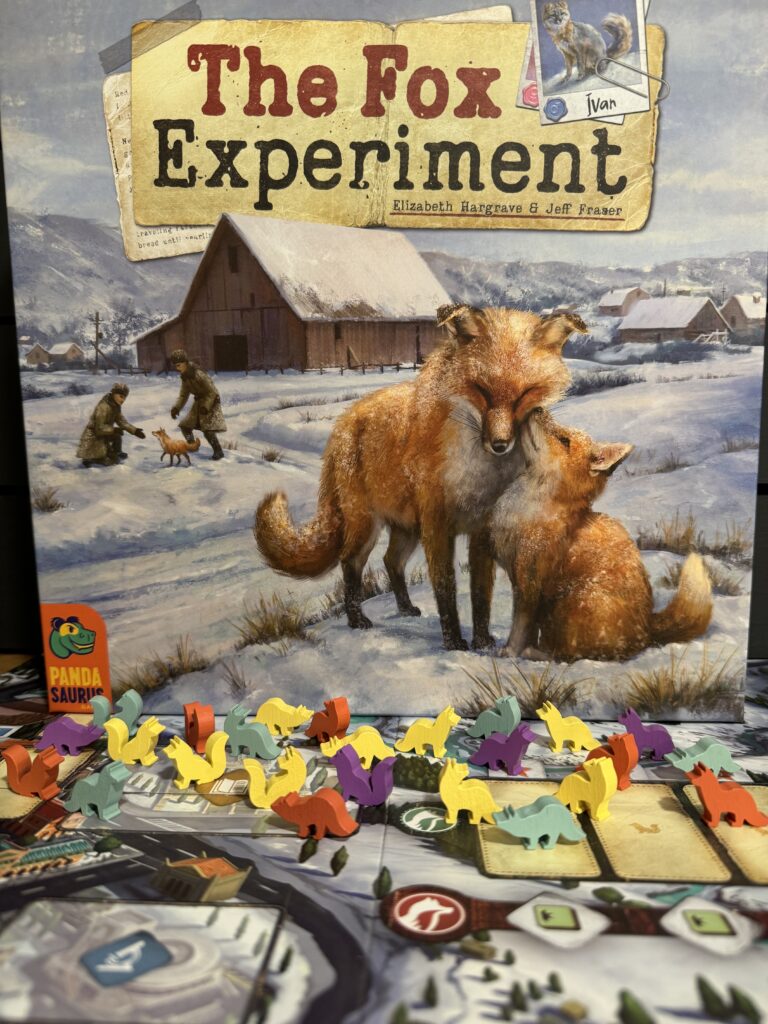
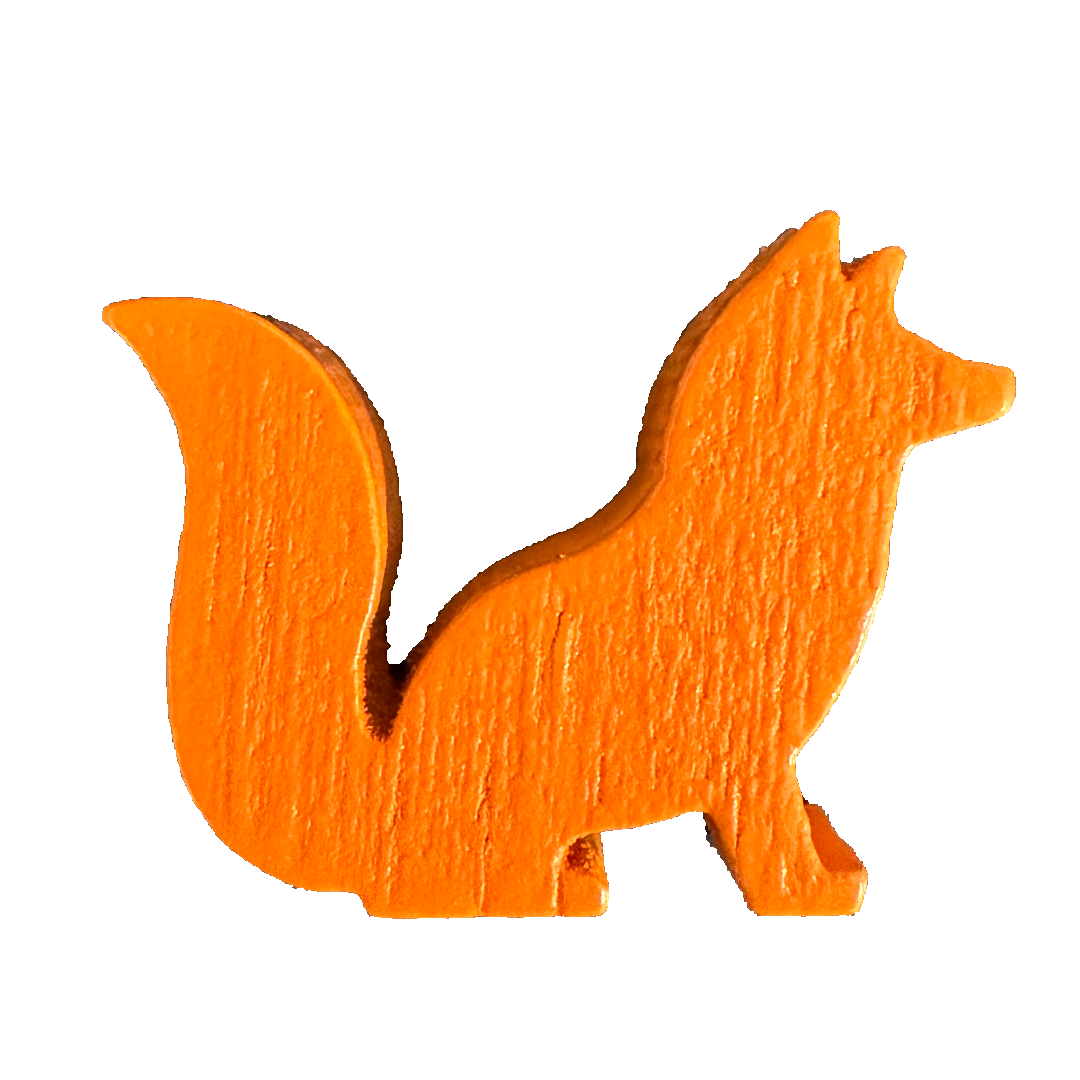 Components
Components